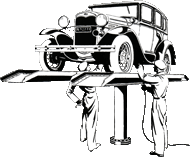
Model B
Ford Garage
Zenith Carburetor Power Jet Circuit
The illustration below is taken from the original Ford detail drawing B-9510-A of the Model B Ford Zenith carburetor. This shows the basic power jet circuit. Fuel is metered from the float chamber through the B-9594 power jet into the well.
The fuel in the well is drawn into the carburetor bore (above the venturi and below the throttle valve) through the B-9595 power jet tube which is pressed into the upper carburetor casting.
There is a very small hole bored into the throttle bore casting where the gas enters the air stream. This operation is controlled by the vacuum above the power jet tube, which is controlled by the throttle shaft air valve position.




Pictured above is an end view of the throttle shaft air valve in the idle position (valve open). This air valve circuit is above the tube and leads to the throttle shaft. The throttle shaft has a flat machined on the end which opens or closes atmospheric air above the fuel in the power jet tube.


When the throttle shaft is in an open throttle position, the machined flat does not align with the atmospheric vent hole in the upper casting (valve closed), so there is a vacuum applied to the power tube by the air flow in the throttle bore.
This vacuum draws fuel up out of the well, through the tube, and into the throttle bore, thereby enriching the mixture. Just like a drink straw emptying a glass.
When the throttle shaft is in the idle position, the machined flat on the throttle shaft aligns with an exterior atmosphere vent hole in the upper casting and provides an air path (valve open) to the air above the fuel in the power jet tube.
This "air leak" prevents enough vacuum from being applied to the power jet tube and prevents fuel from being drawn up through the tube. Thus there is no enrichment during idle or just off-idle throttle positions. Just like a drink straw with an air leak hole in it above the liquid line.
More related information on Ford Garage:
- For more Model A & B related information, use the Site Search box at the top or bottom of this page.
- Model A & B Zenith Carburetor Jet Sizes & Flow Rates
- Model B & 46 Zenith Carburetor Parts Catalog Illustrations
- Model B & 46 Zenith Carburetor Assembly Drawings
- Model B & 46 Zenith Carburetor Float Details
- Model B & 46 Zenith Float Valve Orifice Details
- Model B & 46 Zenith Carburetor Power Jet Tube
- Model B & 46 Zenith Carburetor Power Jet Tube Instructions
- Model B & 46 Zenith Carburetor Catalog Data
- Model B & 46 NOS Zenith Carburetor
- Model B & 46 Zenith Carburetor Upper Casting Variations
Vince Falter
May 2005

